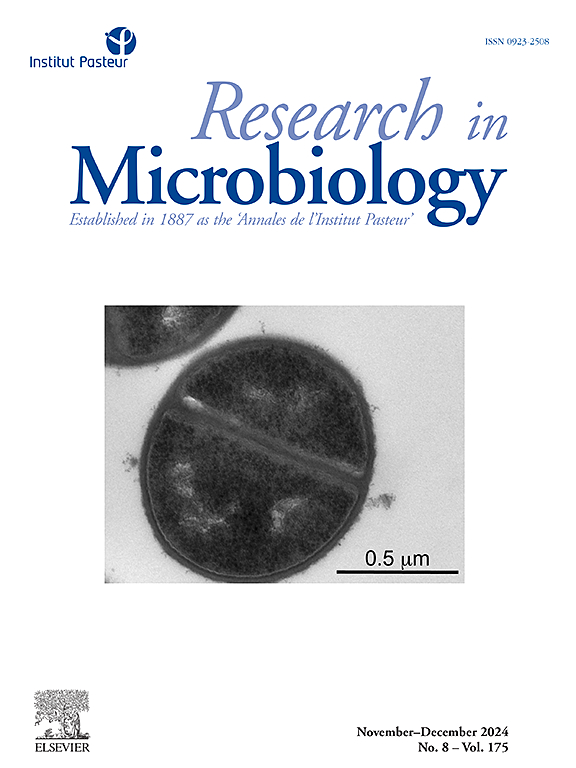Adh1-Car1轴通过抑制菌丝超长调节白色念珠菌二态转变。
IF 3.4
4区 生物学
Q3 MICROBIOLOGY
引用次数: 0
摘要
白色念珠菌是一种常见的机会性真菌病原体,采用二态转化(酵母到菌丝)作为入侵宿主组织和免疫逃避的主要策略。尽管先前的研究已经将ADH1缺失与减弱的毒力表型(如菌丝形成受损)联系起来,但这一现象背后的分子机制仍然难以捉摸。在这里,我们报告了ADH1敲除菌株表现出惊人的菌丝超伸长,偏离了在野生型菌株中观察到的特征分支结构。转录组学分析发现,在adh1Δ/Δ突变体中,精氨酸代谢是最显著激活的途径,编码关键精氨酸酶的CAR1显著上调。至关重要的是,药物或遗传抑制Car1活性完全恢复了ADH1敲除菌株的野生型菌丝形态,明确确立了ADH1通过抑制Car1表达来控制菌丝发育。我们的研究结果表明,Adh1-Car1代谢轴是白色念珠菌二态转换的主要调节因子:当Adh1限制Car1维持菌丝分支平衡时,它的缺失会引发精氨酸代谢流量失衡,导致菌丝过度伸长失控。这项工作重新定义了Adh1在乙醇代谢中的典型作用之外的功能范式,将真菌代谢重连接定位为形态发生可塑性的直接驱动因素,并将Adh1- car1轴作为抗真菌干预的高价值靶点。本文章由计算机程序翻译,如有差异,请以英文原文为准。
Adh1-Car1 axis regulates dimorphic transition in Candida albicans by suppressing hyphal hyperelongation
Candida albicans, a prevalent opportunistic fungal pathogen, employs dimorphic transition (yeast-to-hypha) as a central strategy for host tissue invasion and immune evasion. Although prior studies have linked ADH1 deletion to attenuated virulence phenotypes such as impaired hyphal formation, the molecular mechanism underlying this phenomenon remains elusive. Here, we report that ADH1 knockout strains exhibit a striking hyperelongation of hyphae, deviating from the characteristic branched architecture observed in wild-type strains. Transcriptomic profiling identified arginine metabolism as the most significantly activated pathway in adh1Δ/Δ mutants, with marked upregulation of CAR1, encoding a key arginase. Crucially, pharmacological or genetic inhibition of Car1 activity fully restores wild-type hyphal morphology in ADH1 knockout strains, unequivocally establishing that ADH1 governs hyphal development through repression of CAR1 expression. Our findings delineate the Adh1-Car1 metabolic axis as a master regulator of dimorphic switching in C. albicans: while Adh1 constrains Car1 to maintain balanced hyphal branching, its deletion triggers arginine metabolic flux dyshomeostasis, driving uncontrolled hyphal hyperelongation. This work redefines the functional paradigm of Adh1 beyond its canonical role in ethanol metabolism, positions fungal metabolic rewiring as a direct driver of morphogenic plasticity, and nominates the Adh1-Car1 axis as a high-value target for antifungal interventions.
求助全文
通过发布文献求助,成功后即可免费获取论文全文。
去求助
来源期刊

Research in microbiology
生物-微生物学
CiteScore
4.10
自引率
3.80%
发文量
54
审稿时长
16 days
期刊介绍:
Research in Microbiology is the direct descendant of the original Pasteur periodical entitled Annales de l''Institut Pasteur, created in 1887 by Emile Duclaux under the patronage of Louis Pasteur. The Editorial Committee included Chamberland, Grancher, Nocard, Roux and Straus, and the first issue began with Louis Pasteur''s "Lettre sur la Rage" which clearly defines the spirit of the journal:"You have informed me, my dear Duclaux, that you intend to start a monthly collection of articles entitled "Annales de l''Institut Pasteur". You will be rendering a service that will be appreciated by the ever increasing number of young scientists who are attracted to microbiological studies. In your Annales, our laboratory research will of course occupy a central position, but the work from outside groups that you intend to publish will be a source of competitive stimulation for all of us."That first volume included 53 articles as well as critical reviews and book reviews. From that time on, the Annales appeared regularly every month, without interruption, even during the two world wars. Although the journal has undergone many changes over the past 100 years (in the title, the format, the language) reflecting the evolution in scientific publishing, it has consistently maintained the Pasteur tradition by publishing original reports on all aspects of microbiology.
 求助内容:
求助内容: 应助结果提醒方式:
应助结果提醒方式:


